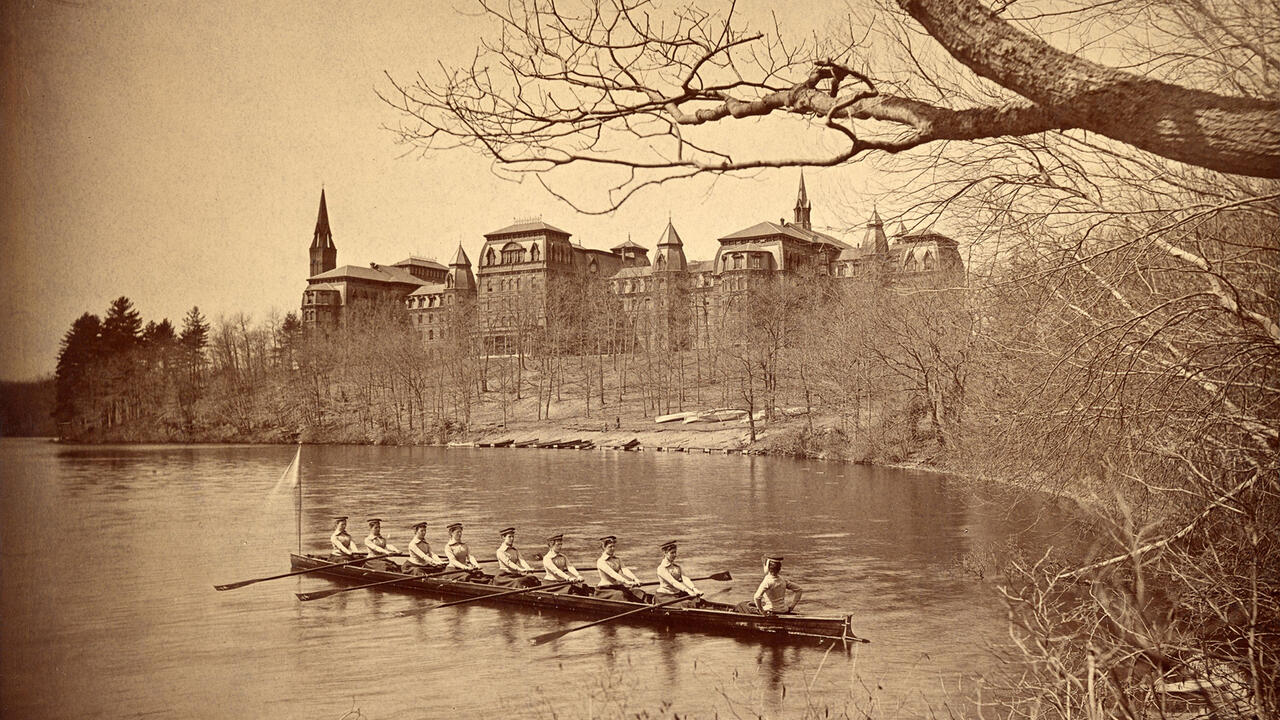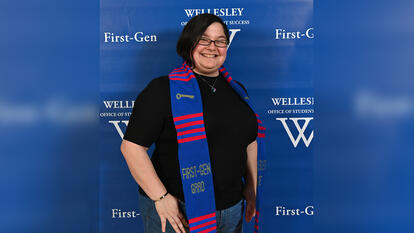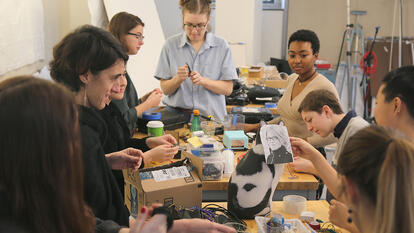
History on the Water: Wellesley’s venerable tradition of rowing—and winning—from Float Night to national championships
After constructing College Hall, the majestic building where 314 students lived and learned when Wellesley College opened its doors in 1875, Henry Fowle Durant bought three rowing vessels and docked them on Lake Waban. These high-railed boats—the Argo, Mayflower, and Evangeline—resembled whaling dories more than today’s sleek low-to-the-water crew shells, and they were propelled by the first collegiate oarswomen in the United States. These inaugural crews launched the College’s enduring rowing journey that by May 2016 found 16 rowers and two coxswains hoisting trophies as the NCAA Division III rowing champions. Blue Crew won the national championship again in 2022.
This year, as Wellesley’s crew races toward a spot in the 2023 championships, the College celebrates 50 years of intercollegiate rowing. How crews moved from unwieldy dories to untippable barges, from racing fours to top-ranked national powerhouse eights, is the story I’m here to tell.
Singing Songs to Sliding Seats
A fervent believer in the mind-body health benefits of vigorous exercise, Durant insisted on a daily hour of outdoor activity for students. But Wellesley’s first oarswomen were selected for their singing voices, as during the College’s first two decades, these rowers’ primary purpose was to entertain the College’s guests. Attired in elaborate boating costumes, the rowers sat primly side by side in pairs on immovable seats and pulled their oars with restrained, ladylike exertion.
Durant revered poetry as much as he took pride in his college’s rowers, and poet Henry Wadsworth Longfellow was the first Wellesley College guest to be rowed on Lake Waban. When Longfellow arrived on campus in fall 1875, he watched the christening of Evangeline, named in honor of his epic poem, before its rowers welcomed him aboard. After an unsettling row, the crew deposited its 68-year-old guest at the base of a craggy hill, which he climbed with difficulty under an archway of uplifted oars. Until his death in 1882, Longfellow visited College Hall often, but never again assented to be rowed to his readings.
By the early 1890s, rowers sat single file on movable seats in longer, lighter, narrower cedar boats that had replaced the bulkier originals. On special occasions such as Float Night, a tradition since the 1880s, class crews paraded in their boating finery through a crowd of spectators before inconspicuously removing their billowy skirts to row in bloomers. In 1893, many of Float Night’s 5,000 ticket holders came by train from Boston to watch the students row on a lantern-lit Lake Waban. Helen Shafer, Wellesley’s then president, assured anyone who might be concerned for the ladies’ well-being that they rowed “not for speed, but for skill and grace,” adding that “racing is not allowed, hence there is no temptation to overstrain.”
In 1897, Wellesley athletes competed against another college for the first time—losing to Radcliffe in tennis. It would take 73 more years for Wellesley rowers to leave Lake Waban to compete against another college’s crew. On a November afternoon in 1970, five members of the class of ’73—rowers Wendy Evrard Lane, Sally Brumley Keller, Liz Senear, and Gigi Coe, and cox Debbie Kaegebein—borrowed a racing four from MIT, then handily defeated two MIT women’s crews in a 500-meter race on the Charles River. They returned home with no medal, nor was their race included with the results of the men’s races. Senear ruefully remarked to The Wellesley News that the women’s race was planned “as the comedy event of the afternoon,” though neither she nor her fellow rowers had viewed it that way. Leading up to the race, they’d driven in the early morning to MIT to learn how to row a racing four, as Wellesley didn’t own one. The News sports columnist, Mary Young ’76, described the racing shell as a “long, skinny cardboard thin racer, tippy as a kayak,” much tougher to row than Wellesley’s wide “barges.” The 1973 rowers welcomed the challenge, savored their win, and pined for more intercollegiate competition.
This is an excerpt from an article by Melissa Ludtke ’73 that appears in the spring edition of “Wellesley” magazine. Read the full story on the magazine website.



